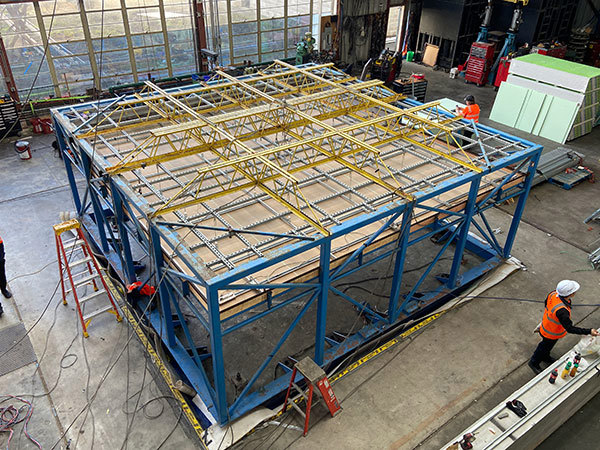Members of the Siniat Technical Team recently travelled to the US to test Siniat’s suspended ceiling systems at the Pacific Earthquake Engineering Research (PEER) Centre at the University of California at Berkeley, USA.
The PEER Centre features the largest multidirectional shaking table in the US. A shaking table is one of the most widely used techniques to assess the seismic performance of building components. Components are subjected to seismic conditions that simulate the most severe earthquakes, and are tested to the point of failure.
The PEER shaking table is configured to produce three translational components of motion; vertical and two horizontal, plus three rotational components; pitch, roll and yaw. These six degrees of freedom can be programmed to reproduce any wave forms within the capacities of force, velocity, displacement, and frequency of the system. The shaking table can subject structures to horizontal accelerations of 1.5G.
“The testing of our products at the PEER Centre has given us a better understanding of how our seismic ceiling systems perform under seismic loads," said Ben Wright, national technical services manager at Siniat.
As a manufacturer of full metal and plasterboard systems, Siniat was able to test fire rated and non-fire-rated suspended ceiling designs.
What are the Australian standards?
During an earthquake, falling debris of collapsed ceilings can attribute to injury and death and that is why seismic design is a regulatory requirement for not only the structural elements of a building, but non-structural components as well.
AS 1170.4 Structural design actions (Earthquake actions in Australia) govern the seismic design of ceilings, and are referenced in the National Construction Code.
The NCC 2022 Volume One contains a Performance Requirement B1P1 (NCC 2019 Volume One BP1.1) that requires Class 2 to 9 buildings to perform adequately under all reasonably expected design actions, including earthquake actions. The corresponding Deemed-to-Satisfy (DTS) Provision for earthquake actions is B1D1 (NCC 2019 Volume One B1.2), which references AS 1170.4.
In terms of NCC 2022 Volume One, Table B1D3a (NCC 2019 Volume One, Table B1.2a), buildings are assessed according to their "Level of Importance". The Level of Importance determines the seismic design requirements of that particular building.
The latest suspended ceiling standard, AS/NZS 2785 Suspended ceilings – Design and installation, was released in 2020 and provides the minimum specifications covering the manufacture and performance of suspended ceilings systems for use in residential, commercial and industrial applications.
“Our systems performed very well during the US testing regime. They were able to withstand accelerations equal to the most severe earthquakes and complied with all Australian Standards.” Ben added.
Siniat can confidently offer a range of seismic design solutions for both suspended and steel stud ceilings, and for fire rated and non-fire-rated applications.
“It is important to note that a structural assessment unique to every project must be conducted by a structural engineer, so they can then design the suspended ceilings” Ben said. “The Siniat technical team is available to help clients with the seismic design of their ceilings from design stage to installation on site.”
To find out more about Siniat’s seismic solutions, click here.

